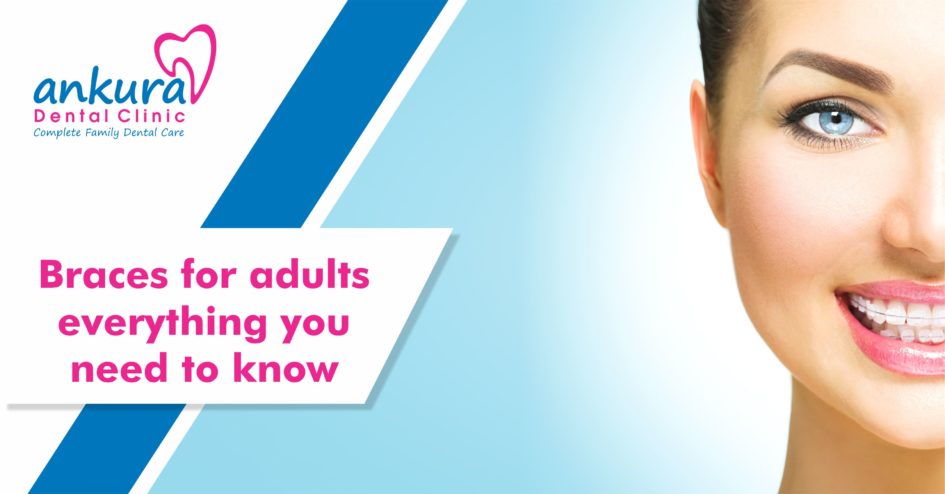We see people of all ages wearing orthodontic braces and the question that pops in our mind is, are they right for me? Braces for adults are becoming a common thing due to incredible advances in its types. Here is everything you need to know before you decide to go for braces and enhance your smile and appearance.
What are Dental Braces?
Dental braces are used in orthodontics that aligns and straighten crooked and crowded teeth and help to position them with regard to a person’s bite.
The application of braces makes the teeth move due to force and pressure on teeth. Thus, the pressure is so made, that the teeth move in the direction as needed.
Most often teenagers are treated with braces but adults too can have them fixed to get a perfect set of teeth.
Why are Braces Necessary?
Most of the orthodontic problems are treated in childhood. Due to many reasons, some people don’t undergo the treatment at the right age. When not addressed properly, orthodontic problems can have a negative impact on your oral health. It’s not too late, getting braces in any age can treat these problems.
The following are the indications that you may need braces if you hadn’t already:
1. Crowding: It is the most common reason to seek orthodontic treatment, especially in kids.
Crowding is insufficient space in the mouth for all the teeth. Without the proper space for all those teeth, the teeth crowd each other resulting in the crooked tooth.
Unfortunately, crowding tends to get worse over time and can make even the simple task of brushing more complicated, requiring more time and effort to clean all teeth properly.
Severe crowding results in areas that are virtually impossible to clean and this leads to plaque accumulation that results in tooth decay, bad odor, and gum diseases.
2. Open-bite: It is an abnormal bite in which the front teeth do not touch. It causes difficulty in biting and speech problems.
3. Crossbite: It is an abnormal bite in which the upper tooth is behind the lower opposing tooth.
If left untreated, this causes fracture of bone teeth and asymmetric jaw closure.
4. Underbite: An under bite is an abnormal bite in which all the upper front teeth are behind the lower front teeth. This sign is usually associated with disproportionate jaw size and may cause imbalance facial appearance and difficulty in biting and chewing.
What do Braces Include?
- Bands – are thin metal rings fitted around the back teeth that serve as an attachment for wires/other appliances.
- Bonded brackets – are small metal attachments cemented directly to the teeth, they have a slot in which archwire fits.
- Archwires – are the main wires that run from one side of the mouth to the other.
- Elastic ties- are tiny O-shaped rings used to hold the wires into the brackets slot.
- Elastic chains- are O-shaped rings, connected to form stretch chains used to move teeth together.
- Hooks – may be attached to the brackets or archwires for the attachments of rubber bands.
Types of Dental Braces:
Today’s orthodontics offer more kinds of braces than ever before. These are
Metal braces: They are generally the least expensive and also the most noticeable. They hold a thin wire in place with bands to put pressure on the teeth and move them to the desired place. These can irritate gums and cheeks at first and once you have them on, you have to watch what you eat and avoid things that can stick to the braces such as caramel or gum.
Ceramic braces: These are similar to metal braces but blend in with the color of the teeth, so they aren’t as visible. Though the braces themselves don’t stain, the ties can easily discolor if you consume food/drinks that stain teeth such as coffee. Your orthodontist will replace the ties every time he or she adjusts the braces, which is usually every month.
Lingual braces: These braces are attached to the inside of the tooth in order to be unseen. These are expensive than the metal and ceramic braces because the process is complicated. Lingual braces don’t work well on small teeth and get in the way of the tongue, which leads to speech problems, so one has to learn and practice speaking with them on.
Invisible braces: Braces like Invisalign are practically invisible, hence desired by many patients who are conscious about their looks. These braces work best for people who don’t have significant teeth problems.
How do Braces work?
Braces work by applying continuous pressure over a period of time to slowly move teeth in a specific direction. As the teeth move, bone changes shape and pressure is applied
Duration to wear braces:
The time required for braces varies from person to person depending on the severity of the problem, the health of the teeth, gums and supporting bone.
On average, however, once the braces are put on they usually remain in place for one to three years.
After braces are removed, most patients will need to wear a retainer all the time for the first six months, then only during sleep.
Retainer: These help in maintaining and stabilizing the position of teeth long enough to permit the reorganization of the supporting structures.
If the patient does not wear the retainer appropriately for the right time amount of time, the teeth may move towards their previous position.
Things to do while using braces
- Use interdental toothbrush.
- Floss at least once a day.
- Use mouth wash.
- Visit your dentist regularly.
Advantages of Braces
- They straighten teeth.
- Close the gaps in teeth.
- Improve facial appearance.
- Bring out a confident smile.
Braces if untreated leads to several long-term problems like:
- Difficulty in teeth cleaning and brushing.
- Swollen gums.
- Loose teeth.
- Bone loss.
- Bad odor.
- Inappropriate facial appearances.
Getting braces not only gives you good looks but also prevent a multitude of problems that can be caused due to irregular teeth. Wearing braces might be uncomfortable for a time period but its rewards are felt for a lifetime.
Authored by: Dr. Zhoor Unnisa
Ankura Dental – Best Dental Clinic in Hyderabad
Tags: All About Adult Braces, Braces For Adults, Can adults wear braces?, Five Options to Get Affordable Braces for Adults, How do Braces work?, The Best Options for Adult Braces, Types of Dental Braces, What are Dental Braces?, What do Braces Include?, Why are Braces Necessary?





May 6, 2017 at 3:13 pm
Very informative! Thanks for sharing the knowledge Dr Zahoor!
May 9, 2017 at 2:15 pm
Good info
May 11, 2017 at 8:19 pm
Good.
May 13, 2017 at 10:36 am
Very helpful information DR zahoor